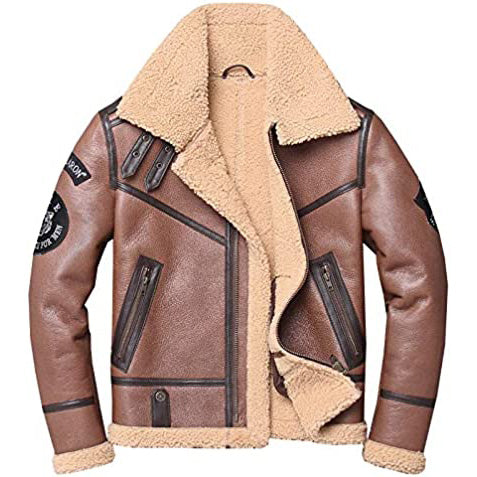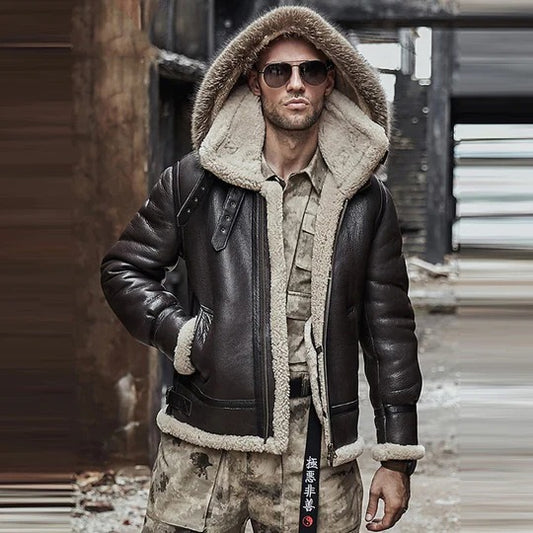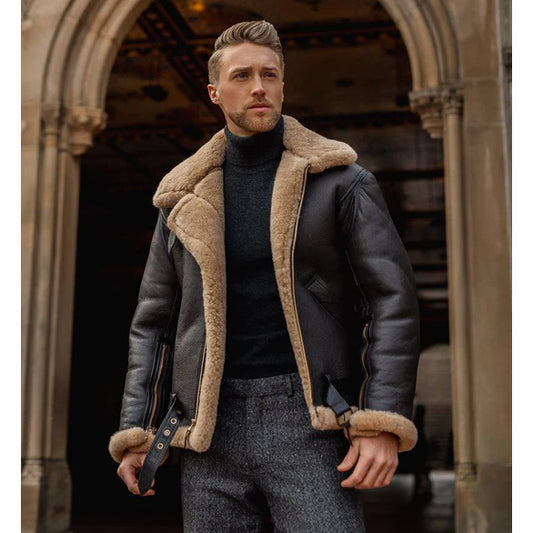Key Takeaways
-
Genuine leather jackets offer unmatched durability, natural texture, and aging potential but come at a higher cost and have ethical/sustainability considerations.
-
Faux leather jackets are more affordable, easier to maintain, and animal-free—but they tend to wear out faster, may show plastic-like texture, and raise environmental issues.
-
Understanding material tests (feel, smell, edge, tag) helps you identify which material you’re buying.
-
Your choice should align with your budget, intended use, style preferences and ethical values.
-
When you’re shopping at Jackets Kingdom or any suede/leather specialist in the USA, knowing these factors will help you make a smarter investment.
Introduction
Imagine stepping into a room wearing a jacket that tells a story—not just of your style, but of its material heritage. That sleek bomber sitting in your wardrobe either grew from the hide of a cow or was spun from polyurethane and impressed to look like leather. The choice between a genuine leather jacket and a faux leather jacket is more than cosmetic it reflects your budget, ethics, durability expectations, and even how you care for your clothes. At Jackets Kingdom we believe in giving you the full picture so your next jacket truly fits your lifestyle. Let’s dive into the difference, and by the end you’ll know which side of the material aisle is right for you.
Definition & origin of genuine leather jacket
A genuine leather jacket refers to a jacket crafted from animal hide—most commonly cowhide in the USA—tanned and finished for garment use. Genuine leather may include several grades (full-grain, top-grain, corrected‐grain) with varying cost and durability. In the American market, many traditional brands such as the jacket maker Overland, Wilsons Leather, and Jackets Kingdom use hides processed via chrome or vegetable tanning. The origin of the hide and how it was banned or regulated often matters to consumers seeking to “buy American.” Real leather hides often come from by-products of the meat industry, thereby utilizing the animal hide rather than producing it solely for fashion.
Definition & origin of faux leather jacket
A faux leather jacket (also sometimes called imitation leather, PU leather, vegan leather) is made from synthetic materials—not animal hide. The base is often polyurethane (PU) or polyvinyl chloride (PVC) layered over fabric or foam backing. In the USA, faux leather has gained popularity for its lower cost point and animal-friendly marketing. That said, “faux” simply refers to the appearance rather than a single standardized material—so quality can vary widely.
Material structure and manufacturing: real vs synthetic
Here the apples‐to-oranges become clear:
Genuine leather manufacturing:
-
Raw animal hide is treated by tanning (chrome or vegetable) to stabilize it.
-
It retains natural grain, pores and varying texture.
-
If high quality (full grain or top grain) it ages, develops a patina, and shows unique irregularities.
Faux leather manufacturing:
-
Synthetic polymer (PU/PVC) layers are applied to a textile backing.
-
Surface is often embossed to mimic the grain of real leather—texture can look “too perfect.”
-
Since it is plastic-based, its wear behavior, breathability and aging differ significantly.
Put simply: genuine leather is a natural hide that’s been tamed; faux leather is an engineered skin made from plastic and fabric backing.
Appearance & texture: how to tell the difference
Recognizing the difference matters—especially when investing in a jacket from jackets kingdom or comparable USA brands.
Genuine leather features:
-
Natural, slightly uneven texture, visible pores or grain irregularities.
-
Raw edges or suede-like underside.
-
When folded or pinched, shows small wrinkles and a rich feel.
Faux leather features:
-
Very uniform grain pattern (may look “too perfect”).
-
Backing may reveal a fabric layer or synthetic foam.
-
Often has a slightly plastic or synthetic feel; sometimes colder to the touch.
-
Smell may lack the distinctive “leather smell.”
A simple test: pinch or fold the jacket material—if it quickly returns to shape with minimal wrinkles, it may be faux. Another: check the tag—terms like “faux leather”, “vegan leather”, “polyurethane leather” indicate synthetic.
Durability & lifespan comparison
When you’re buying a jacket from a brand like Jackets Kingdom, durability plays a big role. Here’s how the two materials stack up:
-
Genuine leather jackets are often built to last decades. With proper care they resist wear, tear and aging beautifully.
-
Faux leather jackets typically have a shorter lifespan: they may crack, peel or lose structure after a few years of heavy use.
-
Because genuine leather develops patina and stays structurally sound, its value per year of use tends to be higher over time.
-
Faux leather appeals if you expect a jacket for short-term seasonal use or lower budget—but long-term value is lower.
So if you say “I want this jacket to be a wardrobe staple for years,” genuine leather is the winner.
Maintenance & care requirements
Different materials, different rules.
For genuine leather:
-
Requires periodic conditioning to prevent drying and cracking.
-
Avoid excessive water or heat; treat stains quickly.
-
Store properly (away from direct sun, avoid folding for long term).
-
Over time, wrinkles and marks contribute character rather than damage.
For faux leather:
-
Easier to clean (often wipeable surface), less need for deep conditioning.
-
However, once cracking or peeling begins there is little you can do—unlike real leather you can’t “refinish” easily.
-
Susceptible to heat damage or prolonged folding may cause creases.
If you value low maintenance, faux leather might seem easier—but remember the durability trade-off.
Comfort, breathability & wear-feel
How a jacket feels on you matters far more than technical specs when you’re walking on the streets of New York, L.A. or Chicago.
-
Genuine leather naturally allows for better breathability and adapts to your body shape. Users often report a “break-in” period where the leather softens and contours.
-
Faux leather is less breathable because of its plastic layers; heat and sweat might build up, especially in warmer U.S. climates.
-
Moreover, the lining and hardware on a genuine leather jacket tend to be higher quality (depending on brand) which improves comfort and fit.
If you’ll wear your jacket often and in variable weather, the comfort of genuine leather is an advantage.
Ethical and environmental concerns
This section brings depth and authority—important for SEO and human readers.
Genuine leather:
-
The hides are often by-products of meat industry in the U.S., reducing waste.
-
However, tanning and dyeing can have substantial environmental impact if not managed properly (e.g., chrome-tanning chemical runoff).
-
Some brands highlight sustainable or vegetable-tanning methods; certification (e.g., Leather Working Group) helps.
Faux leather:
-
Often made of plastics (PU, PVC) derived from fossil fuels.
-
According to reports, faux leather manufacturing can be more polluting than real leather in some cases.
-
End‐of‐life: synthetic leather tends not to biodegrade, adding to landfill burden.
So the “ethical” choice is not always obvious. If vegan is your priority, faux works—but for sustainability and longevity, genuine leather may outperform. Brands like Jackets Kingdom include material sourcing info to help you decide.
Cost and value over time
Numbers matter when you’re investing.
-
Up-front cost: Genuine leather jackets typically cost substantially more than faux leather alternatives.
-
Cost per year: If you buy a high-quality genuine leather jacket and wear it for 10 years, the yearly cost becomes modest. A faux leather jacket might cost less up front but if it lasts 2-3 years then you’ll be replacing sooner.
-
Resale value: Genuine leather may hold resale or vintage value (especially branded ones), faux rarely does.
In short: if budget allows and you plan to wear the jacket frequently, genuine leather offers better long-term value.
Style and aging: patina vs plastic finish
Style evolves. Materials age differently.
Genuine leather:
-
With wear develops a patina—unique shine, softening, slight color shift. Many people value that “worn-in” look.
-
Scuffs, creases, minor marks often add character.
Faux leather:
-
Tends to retain its look (unless it cracks). No patina, may begin to peel or show wear conspicuously.
-
Texture remains uniform, but may start looking artificial over time.
If you like the “vintage, lived-in” look, genuine leather aligns with that aesthetic. Faux works if you want a consistent look year-to-year.
How to spot real vs fake when shopping for jackets
When browsing jackets at Jackets Kingdom or other U.S. retailers, here are practical checks:
-
Tag/label: genuine leather will say “genuine leather”, “real leather”, or list specific grain. Faux will say “faux leather”, “vegan leather”, “PU leather”.
-
Feel the texture and surface: irregularities and natural grain lean genuine; uniform, almost plastic texture suggests faux.
-
Edge/backside: genuine leather has suede-like backing; faux often has fabric or foam backing glued.
-
Smell: genuine leather has a natural earthy leather scent; faux might smell chemical or little at all.
-
Price and brand reputation: if the price seems too low for “real leather”, ask questions or inspect further.
-
Construction details: check stitching, hardware, lining. Poor quality in these might suggest faux or low-grade leather.
Use these steps to avoid buying something marketed as leather when it’s really synthetic.
Expert opinion: what industry specialists say
Authenticity matters. Experts in the leather goods field weigh in:
“Faux leather jackets often claim superiority over real leather, but real leather has numerous advantages in durability and value.” – Industry review.
“Faux leather is much less durable than real leather.” – Gentleman’s Gazette.
These expert perspectives reinforce the idea that if you’re serious about investment and longevity in your jacket, genuine leather remains the gold standard—even if faux leather has improved.
Use-case scenarios: when genuine makes sense, when faux makes sense
Let’s map your decision to real-world scenarios.
Choose genuine leather if you:
-
Expect to wear the jacket frequently.
-
Want a long-term staple piece.
-
Value natural feel, aging character, and potential resale.
-
Are comfortable with higher investment and proper care.
Choose faux leather if you:
-
Are on a tighter budget.
-
Want an animal-free choice or temporary seasonal style.
-
Need a lighter jacket for travel or unpredictable wear.
-
Are willing to accept shorter lifespan in exchange for cost savings or style variety.
At Jackets Kingdom we carry both types; knowing your priorities will help you pick the right fit.
Brand examples & where to buy in USA
In the U.S. market you’ll find several trusted brands:
-
Jackets Kingdom: offers both genuine leather and high-quality faux leather jackets with transparent material descriptions.
-
The Jacket Maker: well-known for custom genuine leather jackets.
-
Overland: premium leather outerwear and accessories.
-
Wilsons Leather: long-established retailer offering genuine leather coats and jackets.
When shopping, check material type, construction, return policy, and reviews. If your purchase is from Jackets Kingdom, look for our care instructions and lifetime value orientation.
Final verdict
So where does that leave you? If you’re investing in a jacket you’ll wear for years, a genuine leather jacket is the smarter choice for quality, durability and long-term value. If you’re looking for budget flexibility, style experimentation or a vegan alternative, a faux leather jacket may serve you well for now—just know the trade-offs.
At Jackets Kingdom we believe in empowering our customers with clarity. Whatever your price point or preference, inspect labels, feel textures, ask questions and choose with confidence. Your new jacket should not only look good—it should fit you and your values for years to come.
Bonus offer: Use code JK25 for a $25 discount on your next purchase at Jackets Kingdom. Don’t wait—upgrade your outerwear game today.
Frequently Asked Questions
Q1: Does “genuine leather” always mean high-quality leather?
Not always. The term “genuine leather” in the U.S. can refer to lower-grades of leather (sometimes heavily processed or bonded). Real high-quality leather is often labeled “full-grain” or “top-grain”.
Q2: Is faux leather better for rainy weather?
Faux leather often has better water-resistance and requires less conditioning, but it may trap heat and will show wear faster. Genuine leather can handle rain if treated but requires proper care afterward.
Q3: Are faux leather jackets more “ethical”?
They are animal-free, which appeals to some buyers, but that doesn’t automatically make them environmentally friendly. Synthetic materials can carry heavy plastic and toxic manufacturing burdens.
Q4: How often should I condition my genuine leather jacket?
Typically every 6-12 months (depending on usage, climate and manufacturer advice) to maintain flexibility and avoid cracking.
Q5: Can I tell by price alone if a jacket is real leather?
Price is a clue, but not a guarantee. Some faux leather jackets may be priced high for brand name. Always inspect the tag, feel the material and check the brand’s material description.





